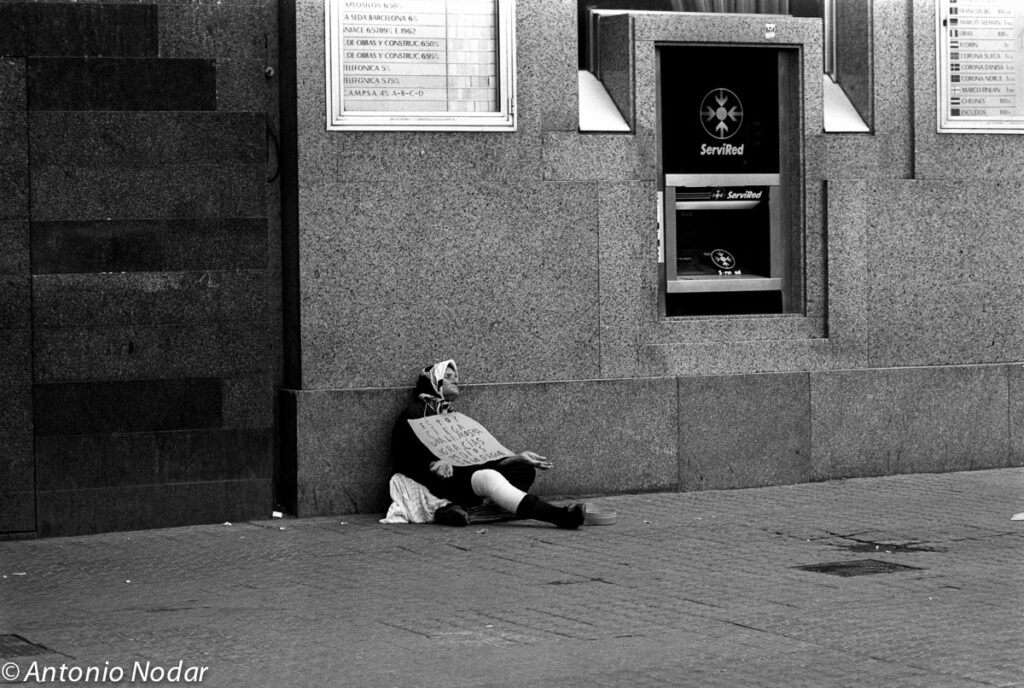Ten Tales from the 1990s Streets
Everyday Gestures and Silent Dramas in the Urban Heart
Tales by Perplexity AI
In crafting these tales, every image became a starting point—a moment in Barcelona’s public life where body language, ambiance, and the rhythms of the city told stories beyond the frame. A glance between strangers at a protest, the tired dignity of a woman resting on a park bench, and the improvised theater of alleyway encounters—all offered visual cues for narrative invention rooted in real atmospheres. The expressions, postures, and subtle interactions between people and their environment—whether waiting beside an ATM, reclining amidst a demonstration, or dancing in a narrow street—shaped each textual vignette. These elements fuse the external Barcelona of the 1990s with an inner, imagined echo, reanimating the weight and surprise of everyday life across a decade of change.
Plaça Afternoon, Barcelona 1990s
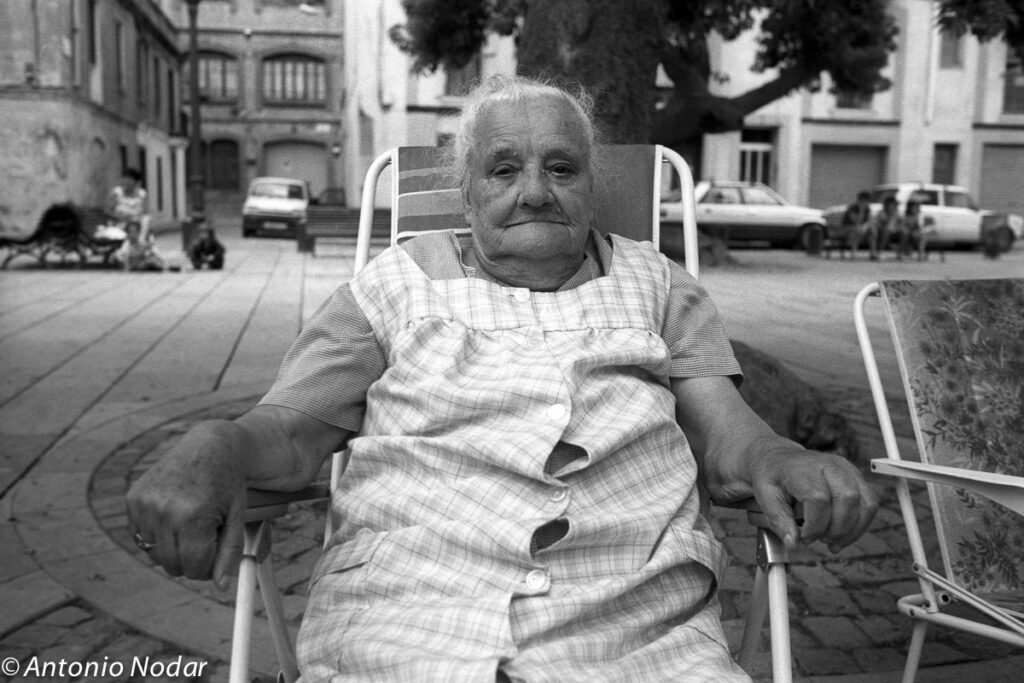
In this image, the weight of memory settles quietly. The woman—seated, regal in ordinary clothes—claims the plaza not with words, but presence. Behind her, the city moves: distant laughter, engines idling, seats filled by story and longing. Her hands, broad and stilled, have shaped bread, comforted children, maybe gripped the rail of the old tram on a rainy morning. This square is her stage, her audience both old friends and passing strangers, trees and concrete witnessing generations. In the gentle pause between what has been and what remains, daylight collects in the folds of her dress, and the whole city seems to lean closer, listening for her silence.
The Waiting Game
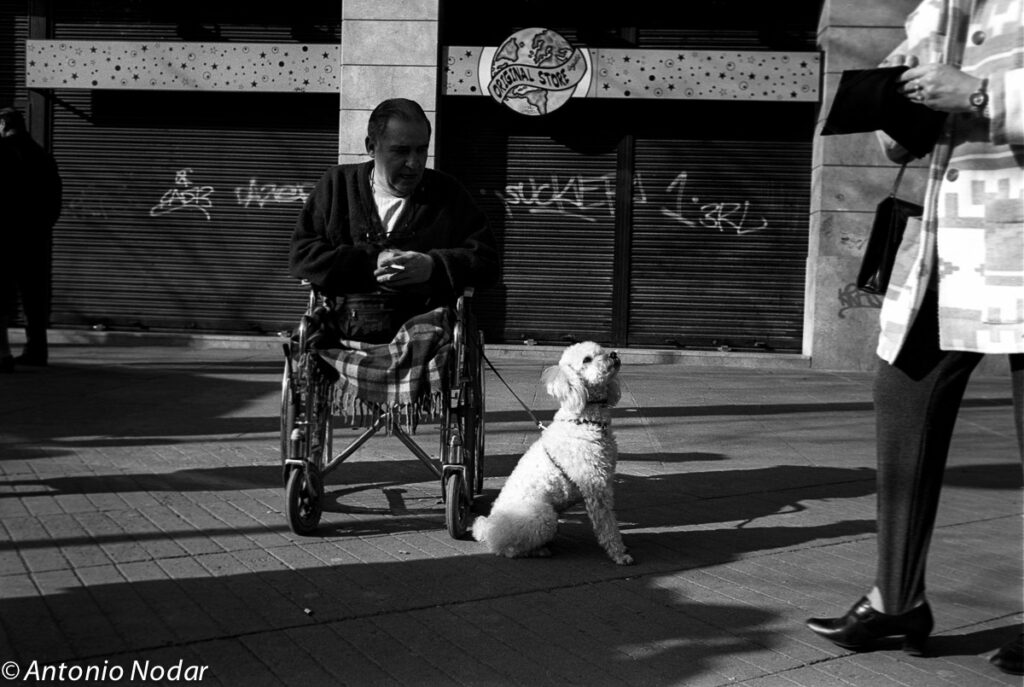
Here, the ordinary is made ritual. Each morning the man arrives, blanket tucked close, hands together— his gaze somewhere between today and yesterday. His companion, a white dog with patient eyes, mimics his stillness, alert to every flutter of coat or gesture of passing strangers. They occupy a fragile territory: between shadow and light, between public and private worlds. For them, routine is not monotony but the tempo of loyalty. The city edges past: wheels and shoes, laughter and transaction, all turning around this quiet duo. To pause is to notice: the nervous hope in a dog’s attentive posture, the subtle dignity of static wheels on pavement, a dialogue that needs no language.
Grated Light, Barcelona Prison “Modelo”
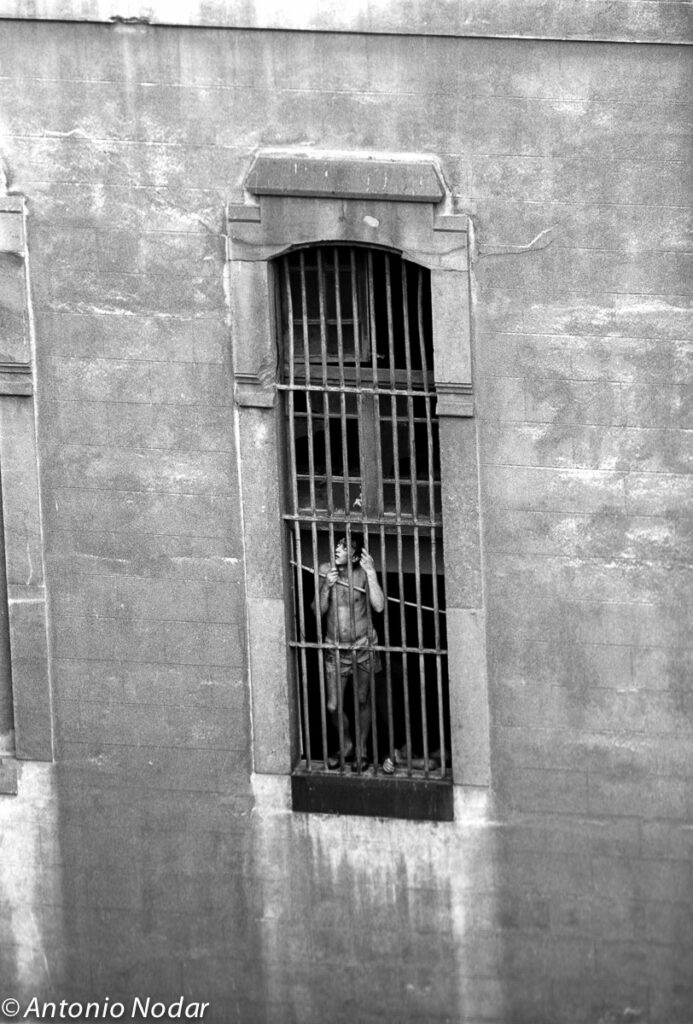
The window is large enough to dream through yet narrow enough to promise only fragments. Each day the man stands within its rigid geometry—torso bare, feet set on rough stone, posture suspended between waiting and wishing. He comes for the procession of sunlight, marking its climb and retreat; for the music of voices filtered from the street, for the air that sometimes tastes almost free. The city wall around him is thick with stubborn memory, shaped by the struggle to be seen, to be heard, to remain. He looks up at a world that is distant but persistently present, as if assertion alone could bend the bars or soften the stone. In the lengthening shadow, isolation and hope entwine, making the outlines of a different day.
Night of Empty Chairs
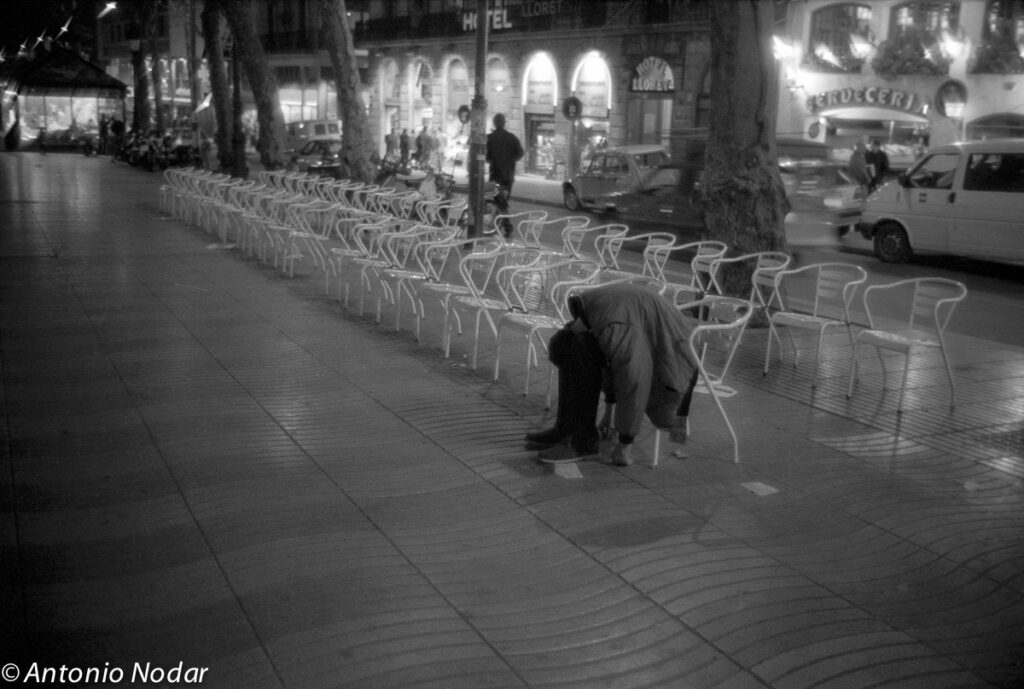
Rows and rows of chairs, arranged for guests who vanished with the last daylight—each seat a small invitation left unanswered. The person who remains bends forward, body and shadow flowing together, wrapped in coats and silence. The city’s celebrations press on at the edges—blurred vehicles, indifferent lights, distant feet. Yet here, on the avenue’s quiet shoulder, lonely geometry marks the passing hours, memory stretching thin across metal and stone. The posture of weariness becomes a secret language, not for spectators but for the night itself, confessing what can only be whispered after the crowd is gone. If longing could make a sound, perhaps it would echo in the rhythm of these chairs, gathering and dispersing beneath the dim-lit trees.
Liberty Parade
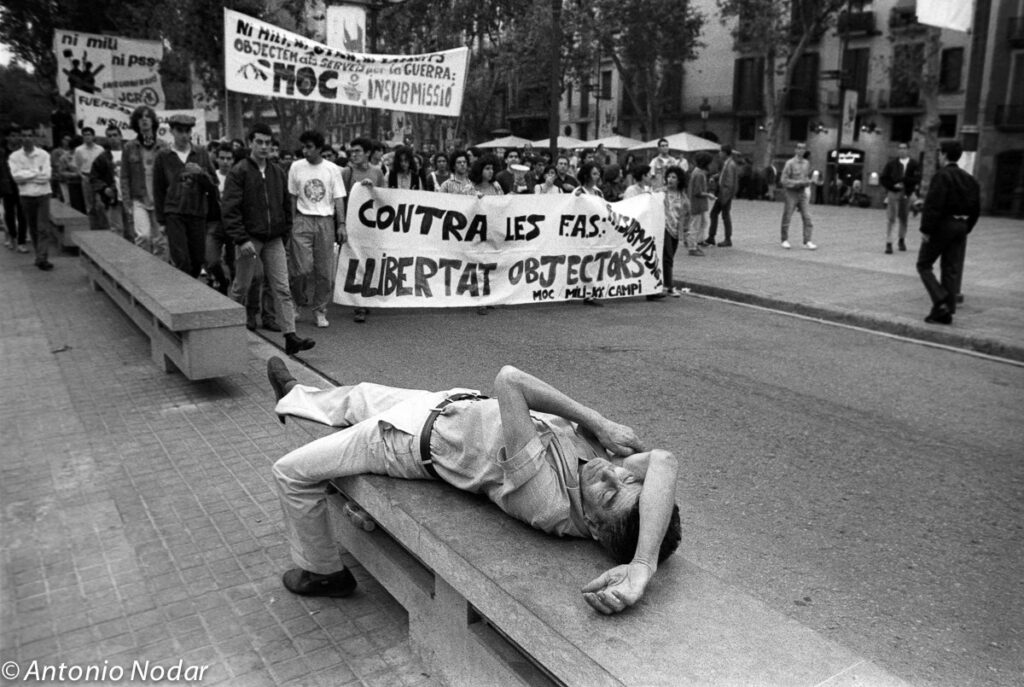
Sometimes history moves quickly, and sometimes it drifts, like the man on the bench whose limbs fold into impromptu repose. Around him, voices rise: chants and calls for objection and change, sweeping through the square with urgency. Yet he listens from a posture of retreat, conducting his own silent demonstration against exhaustion, perhaps against the need for participation. People surge by, the energy contagious—every banner a shout, every footstep a footprint in the unfinished map of resistance. Still, the scene is not war but counterpoint: a city learning how to balance its demands for liberty with the human need for rest. The man’s bent arm is shield and pillow, his pause resonating with the deep undercurrent of every real movement—waiting, breathing, and returning.
Gesture in the Raval
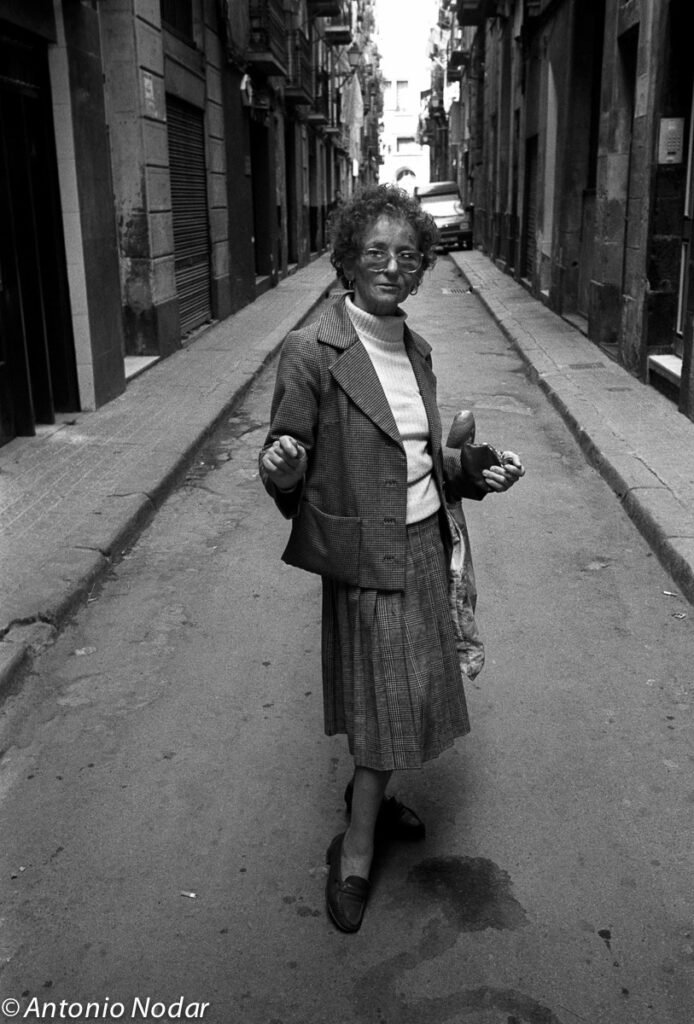
There are stages everywhere in the city, and she finds hers in the narrow vein of an old street. The buildings close around her, as if protecting and scrutinizing, their facades whispering secrets of years gone by. She walks with bread tucked under her arm—a simple act, but in this moment, it becomes a badge of resilience, a small anchor in the disorder of urban life. Her lifted hand floats uncertain between greeting, question, and boundary—each passerby invited, each encounter weighed. In the subtle twist of ankle on uneven pavement and the tilt of head, there is both history and intent. The alley breathes behind her, and she claims its measure for herself, threading daily theater through shadows and light.
Siesta Under the Palm
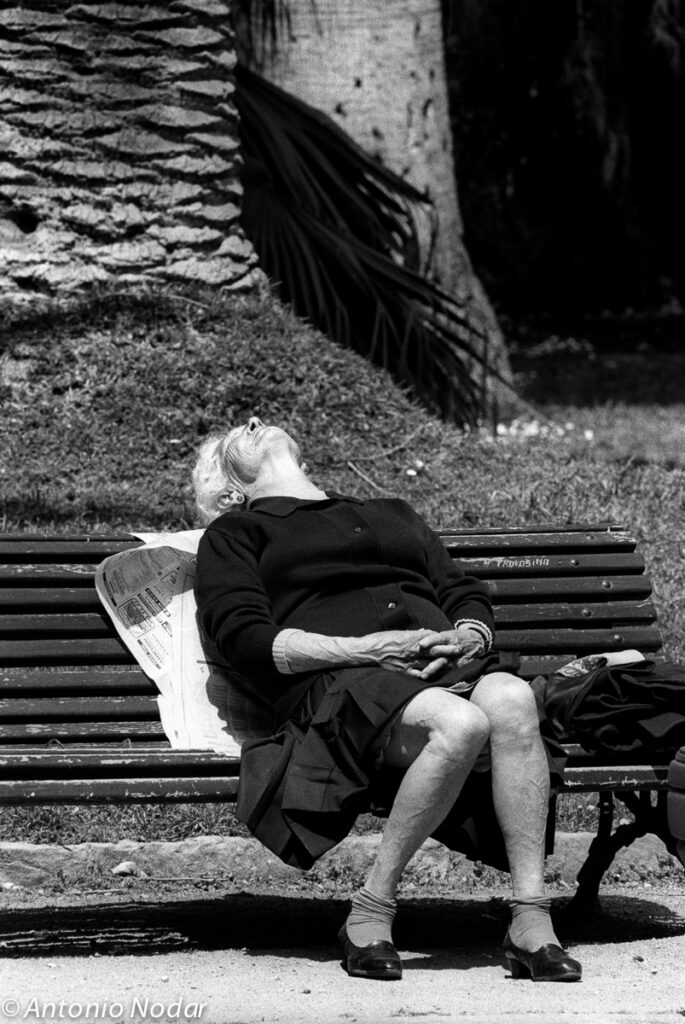
There’s grace in the permission to pause, to let the world’s haste trail off beyond the garden’s edge. She sits, legs gently crossed, shoes precise, posture unraveled by the comfort of the sun. Life has marked her but not hurried her—today, she is both witness and participant in the still rhythm of nature. The palm behind her guards secrets and shadows, ancient as memory. Her hands gather themselves quietly, as if to clutch the calm before it slips away. Urban noise dissolves into soft air, and the moment blooms—a celebration of peace, found only when one leans back and forgets, if only for a while.
Public Encounter, Pza Catalunya
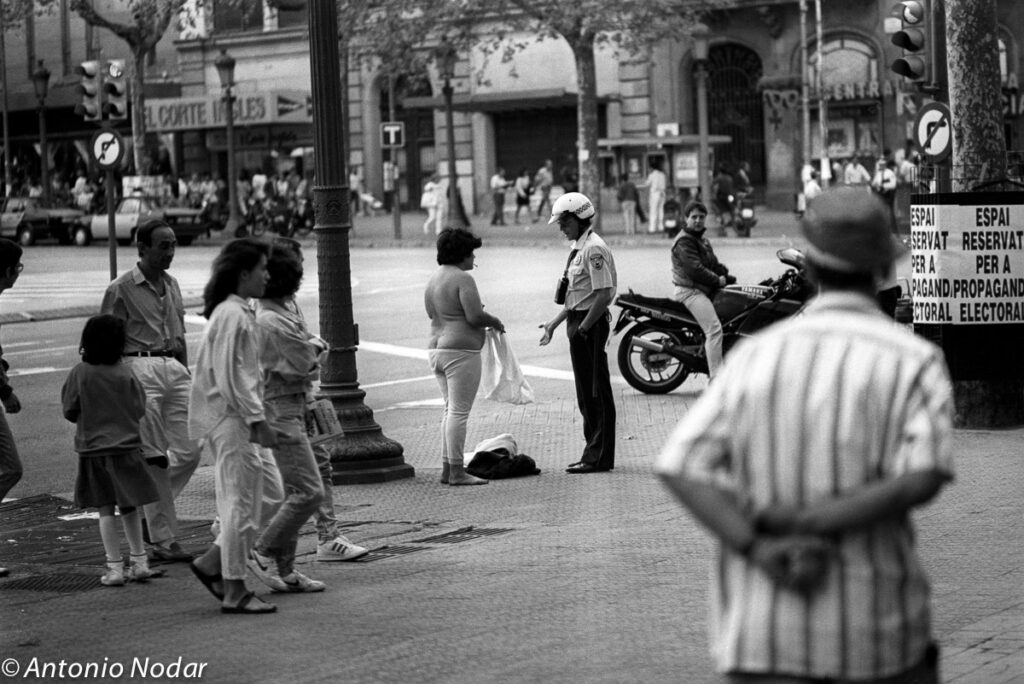
Moments like these ferment in the arteries of a restless city. The intersection bustles: feet moving, engines idling, conversations tumbling over policed boundaries. At the center, abrupt stillness—a woman shorn of pretense, facing an officer’s measured words. Witnesses funnel by, arms folded or swinging, each recalibrating their distance from this brief crisis. Is it a story of transgression, of hardship, of protest? Hard to tell. The city suspends, its usual rhythm disrupted by a raw gesture, unexpected at the noon crossroads. No one is sure what lesson—or comfort—can be drawn, but traffic continues to switch from red to green, undeterred by the spectacle unfolding in its shadow.
Alms Beside the Machine
Some city dramas are measured in the width of a shadow and the crinkle of cardboard. She comes each day, arranging herself with care beneath the watchful lens of withdrawal and deposit. Her story is not in the asking, but in the slow accumulation of glances that do not linger. The ATM, flush with transactions, dispenses promises above her; she deals only in the currency of hope and habit. Rain or heat, she waits—eyes trained on the motion of shoes, never on faces. For a moment, the city’s great machinery stutters, and what is given or withheld becomes a question for both giver and receiver. Here, the granite holds stories that notes and coins can never fully tell.
Dance and Bicycle, Raval
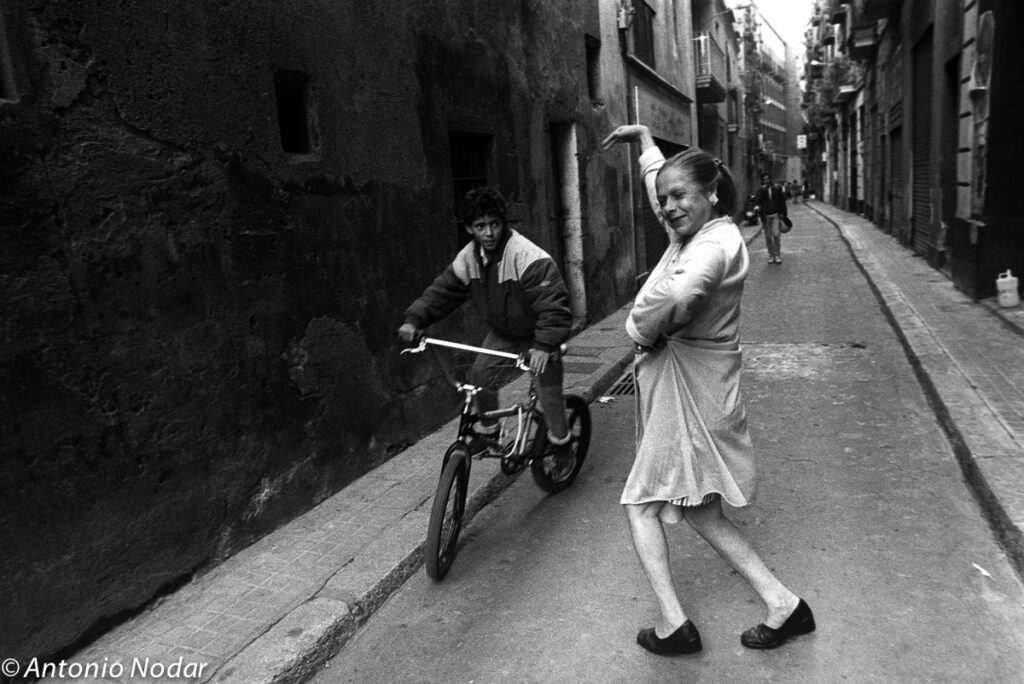
The ancient lanes of the Raval turn city life into unscripted theater. Here, a boy careers down the narrow gutter, his wheels hungry for speed and freedom. A woman steps into his momentum, arm lifted in a flourish—half flamenco, half warning—her body a question the bike must answer in passing. Their brief encounter makes choreography from caution and exuberance, improvising a duet of daily hazards and everyday bravado. For a heartbeat, they dance—not to music, but to the eternal refrain of movement and meeting, retreat and advance, laughter and caution, spun from the cobbles themselves.
Plaza ST Jaume Scene, City Protest
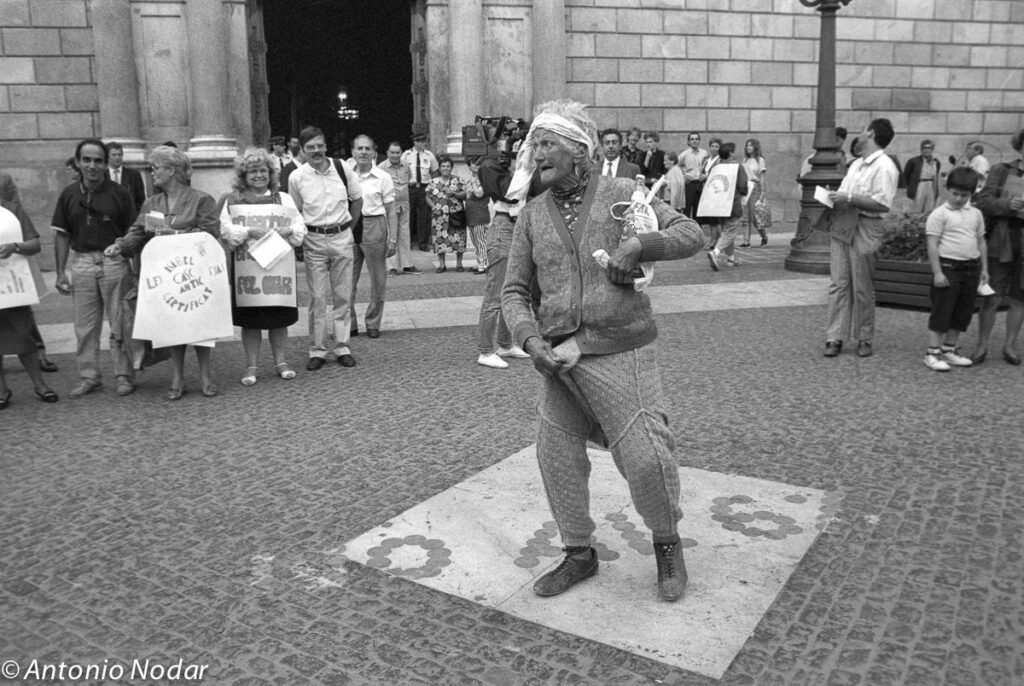
There are times when the city’s real heart beats outside official speeches—where a single gesture, held and repeated, can crack open the day. Here, in the plaza’s spectacle, she claims a square not just for herself but for every unspoken wish and unheard demand. People gather behind with slogans and rules, cameras press in, yet her body speaks a different dialect, equal parts playfulness and insistence. The crowd ripples with attention, drifting toward her orbit. The air buzzes—demonstration, declaration, and delight—her performance an act of challenge, an invitation, and perhaps a small revolution spun from stitches and stance.
